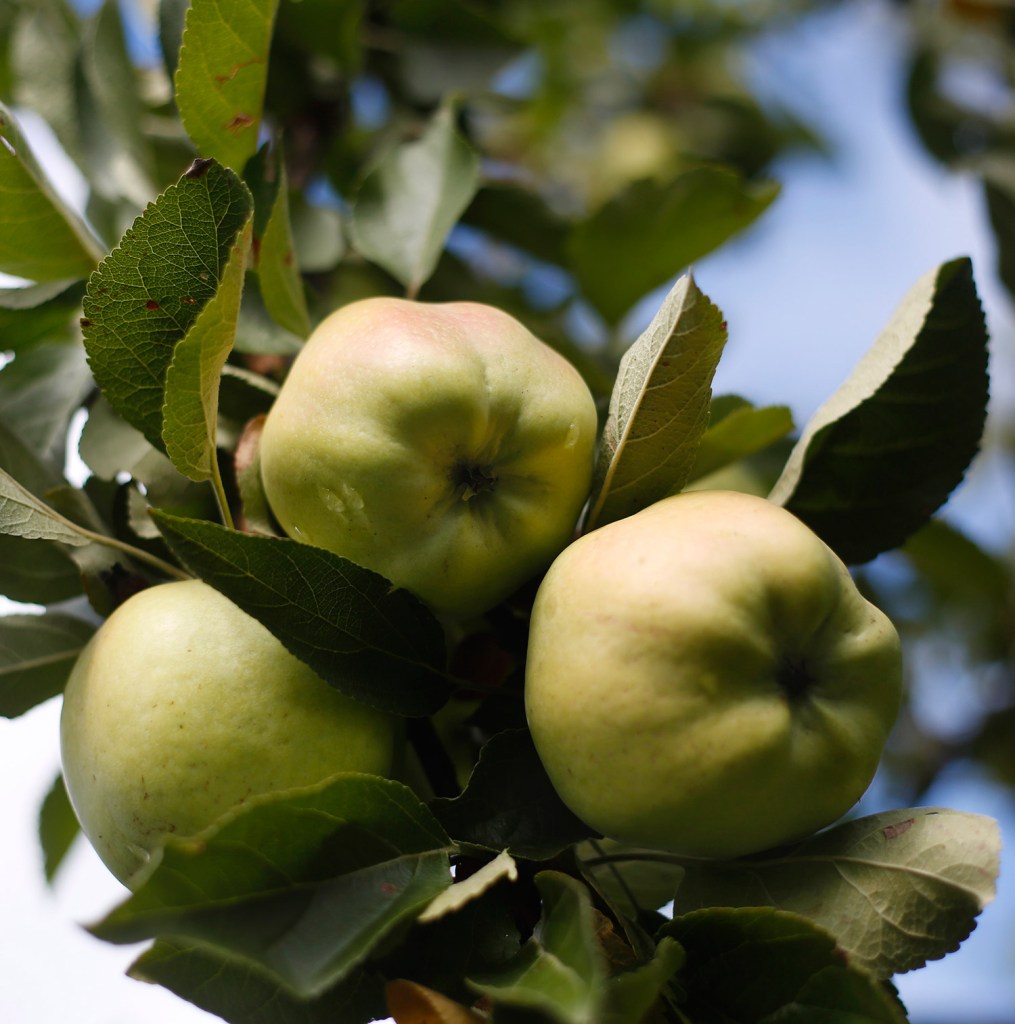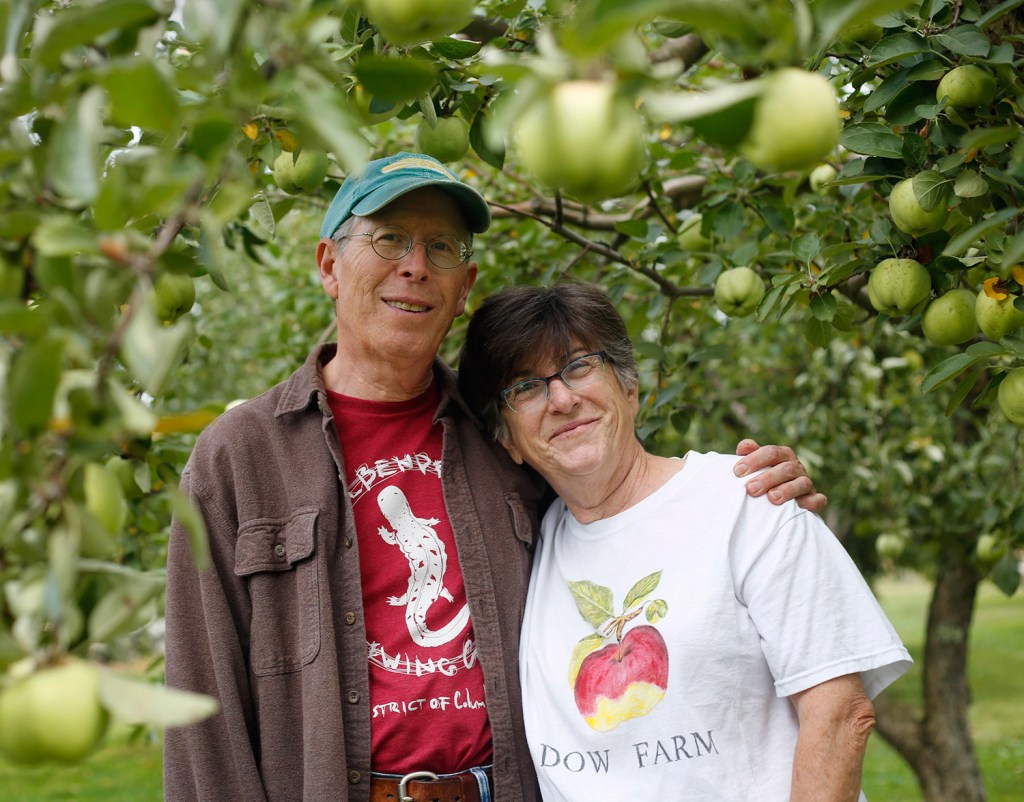STANDISH — Mike Bendzela reached up to a tree dripping with apples and picked a light green fruit with a red blush on its skin. As he handed the apple over, the scent of strawberries drifted through the old orchard on the early autumn breeze. “Isn’t that lovely?” Bendzela said.
Strawberries? In an apple orchard?
This is the Chenango Strawberry, one of 25 varieties of heirloom apples Bendzela and his spouse, Don Essman, grow in the historic orchard at Dow Farm. The house on the farm dates back to at least 1769, and the big red barn was built in 1875. The Chenango Strawberry is about the same age as the homestead; it originated in New York sometime before 1850. Its texture is tender, and it tastes both sweet and tart at the same time – but you won’t find it in supermarkets.
Bendzela and Essman are among a growing number of Mainers who have developed an appreciation for heirloom varieties of apples that for the most part disappeared with the rise of big agriculture. They have replanted varieties that were originally grown on the farm and added more that were once popular in Maine – apples with different textures, unusual tastes and whimsical names, such as King of Tompkins County, Fallawater, Esopus Spitzenburg (a favorite of Thomas Jefferson) and Hubbardston’s Nonesuch.
Dow Farm is selling some of its heirloom varieties at Rosemont Markets, the Portland Food Co-op and the Gorham Farmers’ Market. Even commercial growers are expanding their orchards to add more heirloom apples, which can be a bit more finicky than Honeycrisp and McIntosh. According to Renae Moran, an associate professor of pomology at the University of Maine, the expansion of heirloom apples in commercial orchards in Maine is a “definite trend, but not to a large scale.”
“Most orchards have always had a few trees of old-fashioned varieties but are now planting a few more,” she said.
That’s because the market for them is growing as the public gets a taste of what they’ve been missing all these years.
“I had commercial orchardists say to me a few years ago, ‘I wish I had never grown an heirloom, and I should have cut them all down,'” said Maine apple expert and preservationist John Bunker, “and recently I’ve had commercial orchardists say to me ‘I can sell every heirloom I can get.’ They’re still talking on a smaller scale – they’re not talking about Honeycrisp (scale) – but more and more when I go to commercial orchards they have more heirlooms now.”
Bunker, who runs an heirloom apple CSA called Out on a Limb, grows heritage varieties himself at Super Chilly Farm in Palermo, and this year he is selling some of his crop to Rosemont Markets.
The same renewed interest in heirloom varieties is being seen in “all the fruit-growing areas of the world,” said Tom Burford of Lynchburg, Virginia, also known as “Professor Apple,” an author and apple expert who consults with historic properties, including Monticello, about his favorite fruit.
Burford said one reason for the revival of heirloom apples is the fact that young consumers are more taste conscious. He noted that when he gave lectures a decade ago, “I saw a lot of white hair in the audience, but now they’re in their 20s and 30s, so it gives me great hope.”
“It’s really exciting for me because we are getting back to the fruit culture – the apple culture, especially – the way I knew it as a child,” said Burford, who just turned 80.
Jason and Heather Davis specialize in heirloom varieties at Cayford Orchards in Skowhegan. Jason Davis is the sixth generation to run the farm, and it already had a lot of heirloom varieties when the couple took over 21 years ago – varieties such as Yellow Transparent, Duchess and Wolf River. The farm had been abandoned for 26 years, but some of the apple trees hung on. It took the Davises almost a decade to rehab the old trees.
“Some of these varieties, we couldn’t even practically give them away when we first started because people didn’t know anything about them,” Heather Davis said. “And over time, the older generation found out that we still had them: ‘Oh my god, I haven’t seen them since I was a little girl on the farm.'”
Now customers have started asking them to grow particular varieties, such as Blue Pearmain, which can be used in a variety of ways – pies, applesauce, baked apples.
Burford said the resurgence in cider making has also contributed in a big way to the comeback in heirloom varieties. Casey Holmes, owner of Maine-ly Apples in Dixmont, grows a dozen heirlooms. Six originated in England, five in the United States, and one in France. Half are dessert apples such as the Cox’s Orange Pippin (Holmes says Portlanders travel to his orchard every year to buy those) and the other half are cider apples used to make 200-300 gallons of cider a week. Holmes makes his cider with one thought in mind: “What would John Adams drink?”
“It’s part of our history, really,” Holmes said. “The ones from England are some of the primary cider producers. They’re bitter sweets and bitter sharps. The cider that Thomas Jefferson was drinking was based on the apples that they brought from England before the Revolution. The apples that they were familiar with is what they started making their own cider with, and that’s what we’re trying to replicate.”
The Dow Farm also makes sweet and hard cider each year, and the apples that aren’t used for cider go to market, to the farm’s CSA customers, or to the pigs.
The farm is owned by Claudia White and her husband Ken Faulstich. Don Essman started restoring the old orchard, bordered by a stone wall, when he moved into the place as a tenant 40 years ago.
He and Bendzela (who has lived there for 30 years) are restoring the orchard using a faded, framed map drawn by White’s great-grandfather, Herbert Dow, as a guide. The map lists 11 apple varieties in pencil; they have names like Wagener, Pewauki and Tetofsky. (In spots near the stone fence, Dow simply wrote “Old Trees” – an indication of the age of the orchard.) The rest of the trees Essman and Bendzela have planted, while still old and considered Maine heirlooms, have not grown on the farm before, as far as they know.
Bendzela’s favorite is an apple that will ripen in October, the Yellow Newton Pippin. “When it bears, it bears lovely apples, and they’re almost piney,” he said.
White’s favorite is the Calville Blanc d’Hiver, an oddly shaped apple that Claude Monet painted in his “Still Life With Apples and Grapes” and is now growing in her family’s orchard. The first time White tasted it, she said, it was “the perfect texture, the perfect hardness, the perfect juiciness.”
If these old apples taste so delicious, why did orchardists move away from them? For one thing, while many heirloom varieties are disease-resistant, more varieties mean more work. They can be difficult to grow – and some of them don’t store well.
“Back in the days of subsistence farming, people wanted to have some fruit as early as possible, so the early summer varieties were very popular simply because they provided fruit for sauce and cooking and even some eating, in the month of July,” said Greg Sweetser, owner of Sweetser’s Apple Barrel and Orchards in Cumberland. “They don’t store very long, but when it was just what the family or the farmer used on site, you could have an apple that would ripen for a week and then it was gone, and it was great.”
The Chenango Strawberry is a good example of that, and is one heirloom apple that will probably never make it into supermarkets, no matter how good it tastes. The fruit matures over a period of three weeks, so the apples have to be picked almost daily as they ripen, Bendzela said. For a commercial orchard, he said, “it’s too much work.”
“If you let them turn red, they’re done. They’re junk,” he said, picking up an apple from the ground and watching as his thumb easily pierced the fruit. “See how soft it is when it gets red?”
When he takes the apples into Rosemont Market, Bendzela instructs them to keep the apples refrigerated and sell them the same week.
Running a heritage orchard is full of such tricky issues.
“Every spring I feel like a novice when I go out there,” Bendzela said. “There’s different pest pressures. New trees are blooming that didn’t bloom the year before. They bloom at different times. You have to wait until they all drop their blossoms before you can spray.”
Another problem is that some varieties only bear well every other year. At Dow Farm this year, the Baldwin trees are heavy with apples. Baldwin was once the dominant apple in New England until a sudden deep freeze in the winter of 1934 killed millions of trees and ruined orchards. When it came time to replant, orchardists replaced Baldwin with McIntosh.
“One of the problems with the Baldwin is it bears every other year, so this tree won’t have any apples next year,” Bendzela said. “That’s why they have macs now, because they bear annually.”
Harvesting apples every other year wasn’t such a big deal in the old days, Bunker said. If a farm’s apple trees didn’t bear fruit, it was probably also producing milk or making barrels or raising pigs. But all that changed with the industrialization of agriculture, which requires large crops every year possible, which means relying on a smaller variety of quirky apple trees.
“By adopting a commodity form of agriculture as we have over the past 100 years, one of the necessary evils is that we have to have the varieties that will allow us to have that form of agriculture,” Bunker said. “As we reconstruct agriculture, there will be more success in growing things like heirloom apples.”
Meanwhile, the public has grown used to eating apples that look good, but have little taste.
“For some people, heritage breeds are scary to look at,” Heather Davis said. “A Duchess, for instance, is a pretty pale yellow in color. It’s got very little red streaking on it. It’s actually very pretty when it’s all streaked out like it’s supposed to be, but our culture has just been bred that you want a big red apple.”
The Davises (who named their three children after old varieties of apples) do what they can to spread the word, including sending several cases of heirloom apples to their local school district every year for its snack program. Heather Davis offers visitors a bite of a Martha crab apple, which dates back to 1889 and is about the size of a half dollar. “People look at me like I’m silly when I say ‘Try that, eat that,'” she said. “They say ‘But it’s a crab apple.’ Just take a bite. Their face lights right up and they say ‘I never knew that crab apples could taste so good.'”
Send questions/comments to the editors.










Success. Please wait for the page to reload. If the page does not reload within 5 seconds, please refresh the page.
Enter your email and password to access comments.
Hi, to comment on stories you must . This profile is in addition to your subscription and website login.
Already have a commenting profile? .
Invalid username/password.
Please check your email to confirm and complete your registration.
Only subscribers are eligible to post comments. Please subscribe or login first for digital access. Here’s why.
Use the form below to reset your password. When you've submitted your account email, we will send an email with a reset code.